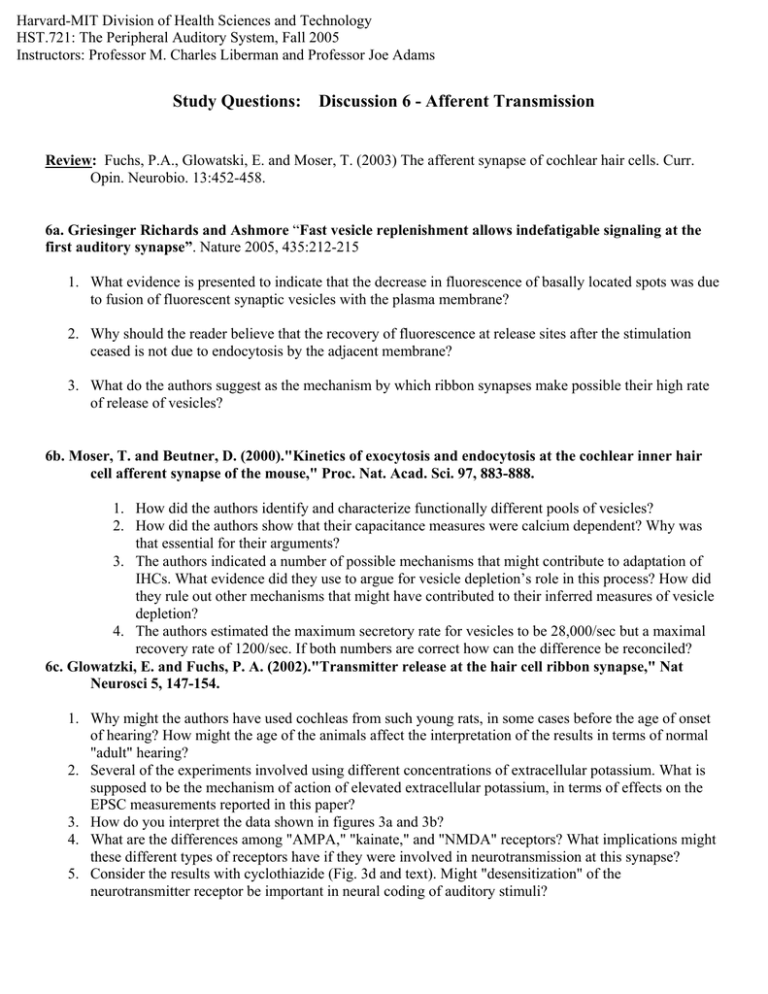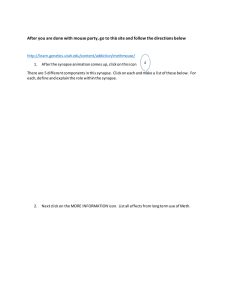Harvard-MIT Division of Health Sciences and Technology
advertisement

Harvard-MIT Division of Health Sciences and Technology HST.721: The Peripheral Auditory System, Fall 2005 Instructors: Professor M. Charles Liberman and Professor Joe Adams Study Questions: Discussion 6 - Afferent Transmission Review: Fuchs, P.A., Glowatski, E. and Moser, T. (2003) The afferent synapse of cochlear hair cells. Curr. Opin. Neurobio. 13:452-458. 6a. Griesinger Richards and Ashmore “Fast vesicle replenishment allows indefatigable signaling at the first auditory synapse”. Nature 2005, 435:212-215 1. What evidence is presented to indicate that the decrease in fluorescence of basally located spots was due to fusion of fluorescent synaptic vesicles with the plasma membrane? 2. Why should the reader believe that the recovery of fluorescence at release sites after the stimulation ceased is not due to endocytosis by the adjacent membrane? 3. What do the authors suggest as the mechanism by which ribbon synapses make possible their high rate of release of vesicles? 6b. Moser, T. and Beutner, D. (2000)."Kinetics of exocytosis and endocytosis at the cochlear inner hair cell afferent synapse of the mouse," Proc. Nat. Acad. Sci. 97, 883-888. 1. How did the authors identify and characterize functionally different pools of vesicles? 2. How did the authors show that their capacitance measures were calcium dependent? Why was that essential for their arguments? 3. The authors indicated a number of possible mechanisms that might contribute to adaptation of IHCs. What evidence did they use to argue for vesicle depletion’s role in this process? How did they rule out other mechanisms that might have contributed to their inferred measures of vesicle depletion? 4. The authors estimated the maximum secretory rate for vesicles to be 28,000/sec but a maximal recovery rate of 1200/sec. If both numbers are correct how can the difference be reconciled? 6c. Glowatzki, E. and Fuchs, P. A. (2002)."Transmitter release at the hair cell ribbon synapse," Nat Neurosci 5, 147-154. 1. Why might the authors have used cochleas from such young rats, in some cases before the age of onset of hearing? How might the age of the animals affect the interpretation of the results in terms of normal "adult" hearing? 2. Several of the experiments involved using different concentrations of extracellular potassium. What is supposed to be the mechanism of action of elevated extracellular potassium, in terms of effects on the EPSC measurements reported in this paper? 3. How do you interpret the data shown in figures 3a and 3b? 4. What are the differences among "AMPA," "kainate," and "NMDA" receptors? What implications might these different types of receptors have if they were involved in neurotransmission at this synapse? 5. Consider the results with cyclothiazide (Fig. 3d and text). Might "desensitization" of the neurotransmitter receptor be important in neural coding of auditory stimuli? 6. What data support the authors' claim of generally "multivesicular" release of transmitter at this ribbon synapse? If only one or a few vesicles had been released at a time, how might the data have turned out? 7. How do the numbers of EPSCs per second in these recording relate to what you've heard about spontaneous firing rates in auditory nerve fibers? 8. At what temperature were the recordings made? What is the "normal" temperature of a rat ribbon synapse in vivo? What might be the implications for interpreting these data?
